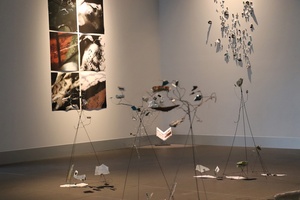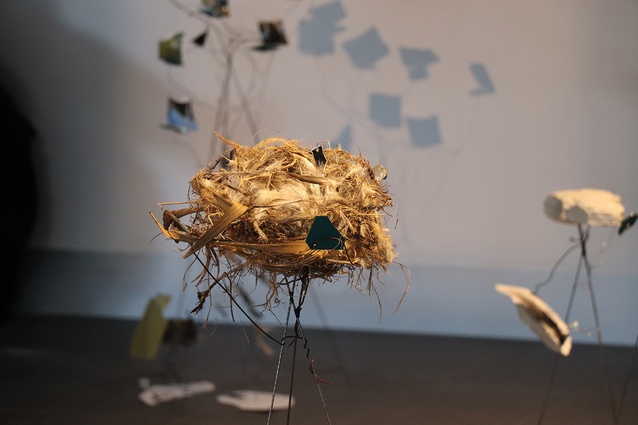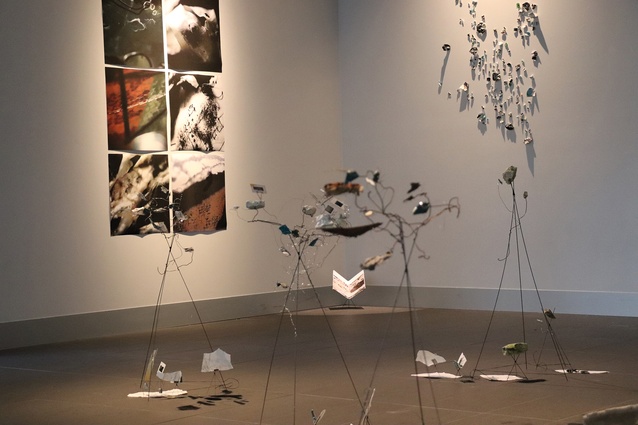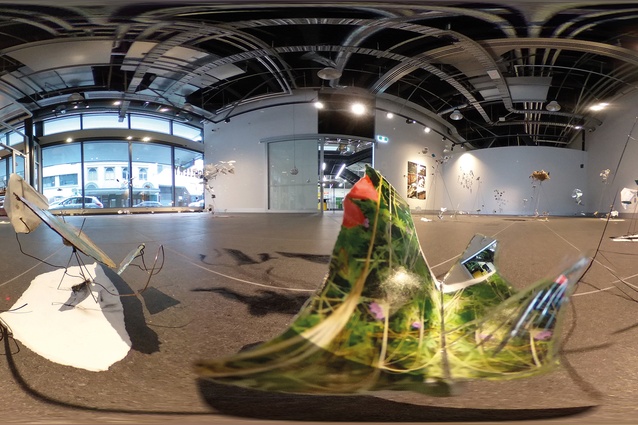Old House: Drawing Interface
I visited architect Simon Twose’s one-roomed installation Old House twice. The first was opening night, when Te Auaha’s gallery was thick with bodies, human and non.

Whilst humans clutched their wine glasses, shifting about the space with interest, Twose’s assembly of ‘sketch creatures’ stood tripodally still, holding ground, as if waiting to burst into activity once we all went away. Like analogue cyborgs, the ‘creatures’ were less singular bodies and more assemblages of incompleteness, cohered around material affinities in an emergent interface between Twose, his dilapidated family cottage and the energetic Kaikōura coast.
Cast beneath the ‘feet’ of the sketch creatures, discontinuous video sequences cut together house sketches and macro photography while a speaker in one corner of the gallery emitted an unearthly crashing of unrecognisable cadence. Rounding out the components of Old House that, together, created what Twose has called a ‘3D sketch’, a VR experience by Sydney-based academic and designer Anastasia Globa is offered.
The second time I visited Old House, I had the room to myself. Alone with the slight, wiry sketch creatures and their full ‘hands’, I felt as though I’d stumbled into a lively world that transcended human scale. Imagination told me I could smell the brininess of sea air as the material vocabulary of rock, seaweed and feathers bound together charcoal rubbings, bits of house and old photos in equal measure. Fragments of mirror wired into the creatures’ bodies formed reflections to multiply reading and unsettle firm orientation of viewer and viewed.
Birthed by Twose at the conjunction of memory, architectural decay, coastal materiality and Kaikōura’s arresting elemental forces, the sketch creatures exuded an at-once intimate and geologicallly scaled presence and peculiar quality of sociability. Spaced across the gridded floor like crabs when a rock is lifted, they expressed a latent dynamism that spoke of order foreign to the orthogonal geometry of the room – or, for that matter, to conventional architectural language. Clearly a family, the same but very different creatures each activated a mute kind of dialogue marking the time of the Twose house and its holdings as simply one part within the material cycles of Kaikōura’s formidable coastline and the inevitability of decay and loss.

Gauged from the life cycles of four generations, Old House is inherently biographical yet is far from any melancholic admission that the material bonds which tie family members to one another and place are impermanent. There is no memorialisation here. Instead, the installation is imbued with a joyous curiosity about the way in which the passing of time stirs, marks patterns and dissolves to impress upon the present. During the conversation with Twose on opening night, stories overflowed that relayed the entangled social ecologies of the Twose family and the varied everyday demeanours of sea life. Sketch creatures, with both love and humour, literally hold the cues to these memories through, for example, the 1970s’ Hanimex Previewer slide tunnel, bits of carpet and fragments of the magnifying sheet through which Nana Twose would read.
Old House convincingly disrupts architectural taxonomies to consider decaying architectural materiality alongside the things for which the house has played host. Rusting fixtures, delaminating lino, flaking paint and rotting architrave are materially aligned with house events, such as Nana Twose’s photo archive, a bird nest from the guttering and movements of insects on window sills. Sketch creatures as architectural complexify and exceed the Twose house as a framework of floor, walls and ceiling. To this extent, Twose’s intimate and expanded drawing practice subverts habitual architectural representation, refusing the viewer any easy access to the old house as a discrete and knowable entity. Instead, we have a plural and partial account where house, inhabitants and environment mingle. Layered up through repetition and immersion, Old House is conceptually collage-like, despite its 3D nature.
Poised on Twose’s sustained provocation of architectural drawing practices, the installation bears witness to the struggles and rewards of invention beyond conventional architectural documentation. Using drawing as a catalyst for a viscerally rich worlding, Old House exemplifies the ways in which architectural drawing evades definition and is, rather, a medium of discovery that surpasses the means for representational identity.













